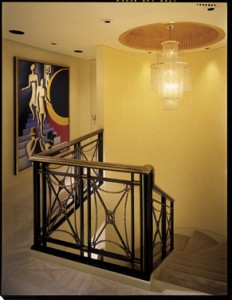
I will always do my best to work within the parameters given to me by my client and will work with any architect they decide to work with. However, with that said, please allow me to give you names of several architects with whom I work well and who will be able to give you what I know you want. If that is not an option, one of the first things necessary will be to give a clear determination of what the architect’s duties are versus my duties. Most clients are not aware of what designers can do and therefore sometimes rely too much on the architect and not enough on the designer to get what they want. Teamwork is the best method of getting everything you want. I am often given the drawings after they are completed so it is very difficult to have the client and architect now entertain concepts contrary to the finished drawings…it can be a waste of time and money, so make sure your designer is on board from the beginning. I have always found it best to start with the architect and the designer from the very beginning. While architects are best at engineering a building, sometimes it takes an interior designer to understand what the client is looking for with regards to how they intend to live in the home, the glamour requirements and definitely the furnishing layouts and much of the function in the home.
For the Designer
Always try to work within the confines of the project, and don’t try to change the overall décor of a room just to suite your tastes, yet you must be true to what the client has asked you to do. The millwork, staircase, moldings and the flooring should always follow the architecture even though you want to create a diverse interior…find a way to do so, but don’t bastardize the architecture in doing so…it makes the home trendy and will be hard to re-sell. Also, it is imperative that you discuss with the client and the architect what your role is in the overall project…do you design all or some of the millwork, are you able to give your opinions on such things as kitchens, baths, closets, staircases, etc.? Some architects won’t want you involved, but always look at the plans and discuss anything you don’t think works for your client…remember, you have a client who comes first.
Find out what the overall vision is, discuss with the client how you want to bring their interiors into play, then specify all of the architectural details such as millwork, tile, lighting and anything that will complete the architectural portion first, then you can concentrate on the interiors. Make sure your floor plans are accurate so the architect can work with you on lighting and any lamps and outlets located to suit your layouts. Always take your own physical measures to make certain the house is actually being built according to the scaled plans you have…if it doesn’t fit, don’t blame the architect.
For Both
There will need to be an overlap of work between the designer and the architect, but don’t worry, they most likely aren’t double billing you. Just because the architect laid out the kitchen does not mean the designer won’t lay it out again, with more detail and more information. Then the architect may add those drawings onto his set for the purpose of electrical, HVAC, etc., but this is what makes a kitchen, or any room for that matter, a great room. You may also bring in a kitchen specialist to assist in adding details and possible custom cabinets, gadgets or specialty items but the cabinets do not make a kitchen alone…the designer needs to ensure the tile, stone and appliances all create the final outcome to best give you what you want. The same goes for any room in your home. Also, the client and the designer need to discuss so many aspects of the home — it will take a lot of devotion and a lot of time…plan ahead for this…it cannot be done in a matter of a few appointments.
Currently we are working on a very large formal home in the western suburbs of Chicago, and there have been so many changes and additions, so many discussions, without complete and accurate drawings, there will be mistakes made, so up-to-date plans are imperative and they must be given to all parties because there will be information needed by all trades, especially on changes.
In the end of the project you will understand why all of the sharing of duties and information was necessary, but up front, you won’t understand what is needed unless you have done this before…if your designer suggests you do a whole house lighting system, he/she is doing this for you benefit, not just because it is the “new†thing to do…so many homes are so complex and so large, you need to do lighting systems so you can ensure the lighting is correct, functioning properly and so it won’t take you 20 minutes to light your home, or more importantly, to be able to turn the whole house off with the flip of one switch. It’s all good.